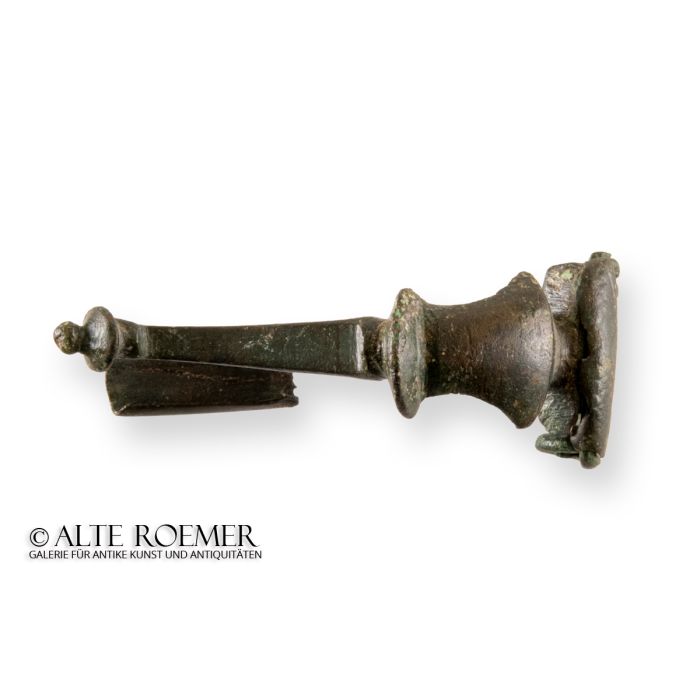Roman Kraeftig Profilierte fibula
Price: on request
Sold
Object number
AR3360-10
| Object: |
Roman Kraeftig Profilierte fibula
|
| Material: |
Bronze.
|
| Period: |
1st century AD. Roman Imperial period. |
| Description: |
Roman fibula of the so-called Kraeftig Profiliert ("strongly profiled") type. The head is under an angle of almost 90°. It is broad and the spring protected by a plate. The foot has a decorative disc and knob. Parts of the original pin and spring are still in place. Hattatt believed that this brooch although found in Britain is not a local production but rather an import from mainland Europe. |
| Background: |
Fibulae were more than just brooches or pins for fastening garments. They were jewellery and status symbol and were worn prominently near the shoulder. This explains the abundance of fashionable shapes and styles that can be observed with surviving ancient pieces. They vary with region, era and social background of the wearer. Modern archaeology uses that distinctiveness to quickly attribute an archaeological find whenever a fibula is part of it.
|
| Dimensions: |
55mm long.
|
| Condition: |
Tip of the pin and part of the spring missing. Otherwise perfect condition with an elegant dark green patina. White inscription "2021" on the brooch. Includes original stand with inscription from the Hattatt collection.
|
| Provenance: |
Acquired by us on the British art market in 2021. Exported under British export licence no. PAU/01443/22. Previously in the inventory of a British art dealer, acquired from the British collector Martin Schoyen. Mr. Schoyen purchased the fibula from the London antiquarian Bernard Quaritch. He bought it at the Christie's London auction on 7 July 1993, lot 72. Previously in the British private collection of Richard Hattatt, collection no. 2021. Acquired between 1970 and 1985. Wroxeter in Great Britain has been passed down as the find spot. About Richard Hattatt: After retiring from the family business, Richard Hattatt devoted himself to collecting and studying antiquities. After a few years, focusing on the area of fibulae, one of the most important collections of ancient brooches from the region north of the Mediterranean emerged. In the years 1982, 1985, 1987 and 1989, four books were the fruit of a tireless analysis and work on the specimen in his collection. Those books are now regarded as standard works in the field of Iron Age and Roman brooches. When Richard Hattatt died in 1992, parts of his collection were already housed in the Ashmolean Museum (Oxford) and the Wiltshire Museum (Devizes). Other fibulae in the collection went to auction houses and into private collections. However, the enormous gain in knowledge through the systematic collecting activity, the drawings and the information consolidated by Hattatt has been preserved for posterity in his books. It is with the appropriate pride that we can offer you this fibula from Hattatt's collection and his books. |
| Publications: |
This fibula is published in a standard work for ancient brooches, Richard Hattatt, Iron Age and Roman Brooches (1985), pp. 64, fig. 27, no. 334. Note that the numbering in Hattatt's publications differs from the collection numbers written on the fibulae. The fibula is also published in the reference catalogue Richard Hattatt, A Visual Catalogue of Richard Hattatt's Ancient Brooches (1989), p. 325, fig. 184, no. 334. |
| Literature: |
As an alternative to the works of Hattatt we can recommend the following book as an introduction and for referencing: R. Heynowski, Bestimmungsbuch Archäologie 1, Fibeln (2012). |
| Authenticity: |
We unconditionally guarantee the authenticity of every artefact, all items are subject to our lifetime return policy on authenticity.
|


